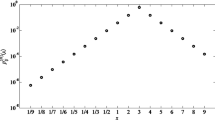Abstract
The technique of paired comparisons is commonly used for finding an optimal solution to multi-criteria decision-making (MCDM) problems. The process of comparing alternatives is worth investigations due to the limitation and complexity of human cognition. In this paper, we propose a cyclic sequential process of pairwise comparisons to produce a real-valued preference relation without reciprocal property. The non-reciprocal property characterizes the uncertainty experienced by the decision maker (DM). The concepts of consistency and approximate consistency are defined by considering the inherent property of the derived uncertain preference relation. An optimization model is given to elicit the priority vector from uncertain preference relations. A novel yet effective possibility degree formula is established to rank interval numbers. A new decision making model is constructed and illustrated by carrying out numerical examples. As compared to the existing works, a novel process of pairwise comparisons is proposed to generate an uncertain preference relation and cope with the uncertainty in a decision making problem. The proposed model can be used to reduce the workload of providing pairwise comparisons for the DM and reach an acceptable decision.










Similar content being viewed by others
References
Arrow KJ (1963) Social choice and individual values (Second version). Wiley, New York
Keeney RL, Raiffa H (1993) Decisions with multiple objectives: preferences and value tradeoffs. Cambridge University Press, Cambridge, p 569
Wallenius J, Dyer JS, Fishburn PC, Steuer RE, Zionts S, Deb K (2008) Multiple criteria decision making, multiattribute utility theory: recent accomplishments and what lies ahead. Manage Sci 54(7):1336–1349
Saaty TL (1980) The analytic hierarchy process. Mcgraw-Hill, New York
Xu ZS (2015) Uncertain multi-attribute decision making: methods and applications. Springer, Berlin
Huang XF, Zhan JM, Ding WP, Pedrycz W (2022) An error correction prediction model based on three-way decision and ensemble learning. Int J Approx Reason 146:21–46
Huang XF, Zhan JM, Sun BZ (2022) A three-way decision method with pre-order relations. Inf Sci 595:231–256
Deng J, Zhan JM, Xu ZS, Herrera-Viedma E (2022) Regret-theoretic multiattribute decision-making model using three-way framework in multiscale information systems. IEEE Trans Cybern. https://doi.org/10.1109/TCYB.2022.3173374
Wang JJ, Ma XL, Xu ZS, Zhan JM (2022) Regret theory-based three-way decision model in hesitant fuzzy environments and its application to medical decision. IEEE Trans Fuzzy Syst. https://doi.org/10.1109/TFUZZ.2022.3176686
Ho W, Ma X (2018) The state-of-the-art integrations and applications of the analytic hierarchy process. Eur J Oper Res 267(2):399–414
Chen YS, Li JH, Li JJ, Lin RD, Chen DX (2022) A further study on optimal scale selection in dynamic multi-scale decision information systems based on sequential three-way decisions. Int J Mach Learn Cybern 13:1505–1515
Rezaei J (2015) Best-worst multi-criteria decision-making method. Omega 53:49–57
Liu F, Zhang JW, Zhang WG, Pedrycz W (2020) Decision making with a sequential modeling of pairwise comparison process. Knowl-Based Syst 195:105642
Liu F, Qiu MY, Zhang WG (2021) An uncertainty-induced axiomatic foundation of the analytic hierarchy process and its implication. Expert Syst Appl 183:115427
Benítez J, Carpitella S, Certa A, Izquierdo J (2019) Management of uncertain pairwise comparisons in AHP through probabilistic concepts. Appl Soft Comput J 78:274–285
Liang F, Matteo B, Rezaei J (2020) Consistency issues in the best worst method: measurements and thresholds. Omega 96:102175
Liu F, Zhang JW, Zou SC (2020) A decision making model based on the leading principal submatrices of a reciprocal preference relation. Appl Soft Comput 94:106448
Liu F, Zhang JW, Luo ZH (2021) Group decision support model based on sequential additive complementary pairwise comparisons. Appl Intell 51:7122–7138
Wang Y, Sun BS, Zhang XR, Wang Q (2020) BWM and MULTIMOORA-based multigranulation sequential three-way decision model for multi-attribute group decision-making problem. Int J Approx Reason 125:169–186
Knight FH (1921) Risk, uncertainty, and profit. Houghton Mifflin, Boston, MA
Marchau VAWJ, Walker WE, Bloemen PJTM, Popper SW (2019) Decision making under deep uncertainty: from theory to practice. Springer, Switzerland AG
Moorse RE (1966) Interval analysis. Prentice-Hall, Englewood Cliffs
Zadeh LA (1965) Fuzzy sets. Inf Control 8(3):338–353
Atanassov K (2012) On intuitionistic fuzzy sets theory. Springer, Berlin, Heidelberg
Duan JY, Li XY (2021) Similarity of intuitionistic fuzzy sets and its applications. Int J Approx Reason 137:166–180
Liu F, You QR, Hu YK, Zhang WG (2021) The breaking of additively reciprocal property of fuzzy preference relations and its implication to decision making under uncertainty. Inf Sci 580:92–110
Saaty TL, Vargas LG (1987) Uncertainty and rank order in the analytic hierarchy process. Eur J Oper Res 32(1):107–117
Cavallo B, Brunelli M (2018) A general unified framework for interval pairwise comparison matrices. Int J Approx Reason 93:178–198
Liu F, Zou SC, Li Q (2020) Deriving priorities from pairwise comparison matrices with a novel consistency index. Appl Math Comput 374:125059
Fedrizzi M, Giove S (2007) Incomplete pairwise comparison and consistency optimization. Eur J Oper Res 183:303–313
Alonso S, Chiclana F, Herrera F, Herrera-Viedma E, Alcalá-Fdez J, Porcel C (2008) A consistency-based procedure to estimate missing pairwise preference values. Int J Intell Syst 23:155–175
Meng FY, Chen XH (2015) An approach to incomplete multiplicative preference relations and its application in group decision making. Inf Sci 309:119–137
Harker PT (1987) Incomplete pairwise comparisons in the analytic hierarchy process. Math Model 9:837–848
Xu ZS (2004) Goal programming models for obtaining the priority vector of incomplete fuzzy preference relation. Int J Approx Reason 36(3):261–270
Xu YJ, Patnayakuni R, Wang HM (2013) Logarithmic least squares method to priority for group decision making with incomplete fuzzy preference relations. Appl Math Model 37:2139–2152
Xu YJ, Wang QQ (2017) An optimization method to estimate the missing elements for the incomplete fuzzy reciprocal preference relation, IEEE Int Confer on Fuzzy Syst 1–5
Wang YM, Yang JB, Xu DL (2005) A two-stage logarithmic goal programming method for generating weights from interval comparison matrices. Fuzzy Sets Syst 152(3):475–498
Xu ZS, Chen J (2008) Some models for deriving the priority weights from interval fuzzy preference relations. Eur J Oper Res 184(1):266–280
Xu ZS, Da QL (2002) The uncertain OWA operator. Int J Intell Syst 17(6):569–575
Liu F (2009) Acceptable consistency analysis of interval reciprocal comparison matrices. Fuzzy Sets Syst 160(18):2686–2700
Liu F, Pan LH, Liu ZL, Peng YN (2018) On possibility-degree formulae for ranking interval numbers. Soft Comput 22(8):2557–2565
Wang YM, Yang JB, Xu DL (2005) Interval weight generation approaches based on consistency test and interval comparison matrices. Appl Math Comput 167(1):252–273
Abu-Sarhan ZA (2011) Application of analytic hierarchy process (AHP) in the evaluation and selection of an information system reengineering projects. Int J Comput Sci Net 11(1):172–177
Bryson N, Mobolurin A (1997) An action learning evaluation procedure for multiple criteria decision making problems. Eur J Oper Res 96(2):379–386
Xu ZS (2001) Algorithm for priority of fuzzy complementary judgment matrix. J Syst Eng 16(4):311–314
Wan SP, Dong JY (2014) A possibility degree method for interval-valued intuitionistic fuzzy multi-attribute group decision making. J Comput Syst Sci 80(1):237–256
Acknowledgements
The authors would like to thank the anonymous referees for the valuable comments and suggestions for improving the paper. The work was supported by the National Natural Science Foundation of China (No. 71871072), the Guangxi Natural Science Foundation (No. 2022GXNSFDA035075), and the Innovation Project of Guangxi Graduate Education (No. YCSW2022110).
Author information
Authors and Affiliations
Corresponding author
Additional information
Publisher's Note
Springer Nature remains neutral with regard to jurisdictional claims in published maps and institutional affiliations.
Appendix A
Appendix A
The proof procedures of Theorems 1 and 2 are provided below:
Proof of Theorem 1. (1) Since \(1/9\le a_{nk}\le 9,\) \(1/9\le a_{kn}\le 9\) and further according to Assumption 1, it gives \(1/9<a_{nk}a_{kn}<9\) and \(\left| a_{nk}a_{kn}-1\right| <8.\) Therefore, we have the following result:
meaning that \(CI_{c}\in [0,1).\)
(2) On the one hand, if \(\textbf{A}_{r}\) and \(\textbf{A}_{c}\) are consistent, it follows \(a_{nk}a_{kn}=1\) \((k\in I_{n})\) according to Definition 2. The application of Eq. (5) leads to \(CI_{c}=0.\) On the other hand, when \(CI_{c}=0,\) it is natural to give \(a_{nk}a_{kn}=1\) \((k\in I_{n}).\) In terms of Definition 2, \(\textbf{A}_{r}\) and \(\textbf{A}_{c}\) are consistent.
Proof of Theorem 2. (1) We first consider M2 in Eq. (8) and construct the following Lagrangian function:
It is easy to give:
Then we have
If \(\lambda >0\), then one can get
This means that
The result is in contradiction with the observation in (24).
Similarly, when \(\lambda <0,\) a contradictory result can be reduced. Therefore, we have \(\lambda =0,\) and
Since
it follows
(2) For M1 in Eq. (7), we can construct the following two functions:
where \(b_{nk}=\dfrac{1}{a_{nk}}.\) On the one hand, it is found that
where
Thus, \(\forall \textbf{w}=\{w_{1},w_{2},\cdots ,w_{n}\}, \exists C>0,\) such that \(0\le g_{1}(\textbf{w})\le \frac{1}{C^{2}}g_{2}(\textbf{w}).\) According to case (1), when \(\textbf{w}^{*}=\left( w_{1}^{*}, w_{2}^{*}, \cdots , w_{n}^{*}\right)\) with
it gives \(g_{2}(\textbf{w}^{*})=0.\) In other words, \(0\le g_{1}(\textbf{w}^{*})\le \frac{1}{C_{1}^{2}}g_{2}(\textbf{w}^{*})=0,\) where
On the other hand, \(\forall \textbf{w}\ne \textbf{w}^{*}\), \(g_{1}(\textbf{w}^{*})>0.\) In summary, one has
Rights and permissions
Springer Nature or its licensor (e.g. a society or other partner) holds exclusive rights to this article under a publishing agreement with the author(s) or other rightsholder(s); author self-archiving of the accepted manuscript version of this article is solely governed by the terms of such publishing agreement and applicable law.
About this article
Cite this article
Liu, F., Hu, YK. & Wang, SS. Cyclic sequential process of pairwise comparisons with application to multi-criteria decision making. Int. J. Mach. Learn. & Cyber. 14, 1391–1405 (2023). https://doi.org/10.1007/s13042-022-01705-5
Received:
Accepted:
Published:
Issue Date:
DOI: https://doi.org/10.1007/s13042-022-01705-5




